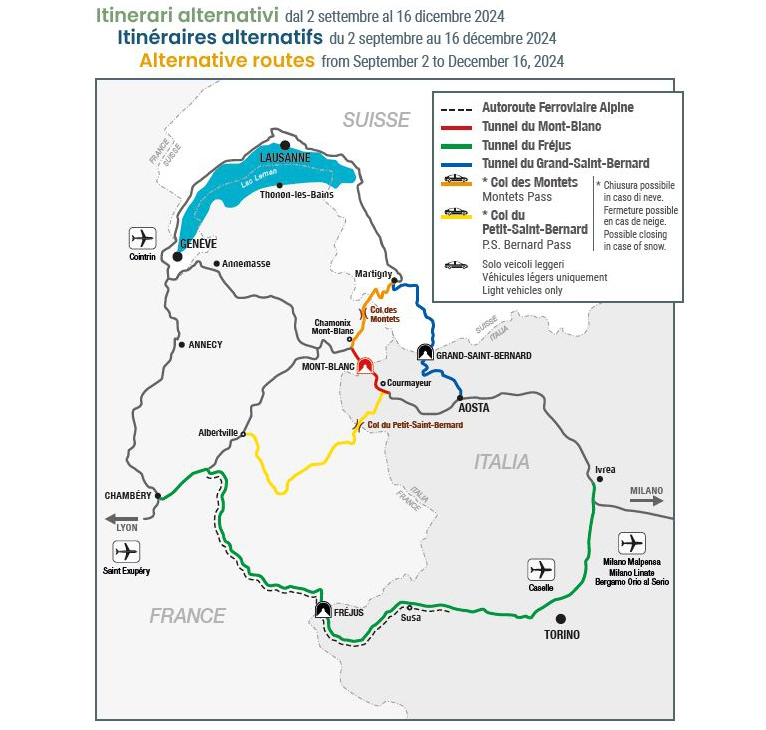
Switzerland – the A13 reopened
The section of the A13 motorway between Lostallo and Mesocco, which was closed following heavy storms and heavy rain in June, was reopened on Tuesday, September 3.
The renovation work, which began on June 24, has been largely completed, making it possible to reopen two lanes in each direction of traffic from Tuesday, September 3.
Extensive work has been carried out in recent weeks, including the removal of debris from landslides, the reinforcement of the motorway embankment next to the river with rock fill and the construction of a protective wall along the carriageway. In addition, the Moesa and Orbel streambeds have been cleared of debris to restore the natural course of the river.
Further cleaning work will take place in the coming weeks, but this will no longer affect traffic.

Germany to introduce temporary checks on the border with France
In connection with the Olympic Games, checks will be introduced on the German-French border from July 20 to September 30. This may slow down HGV traffic.
In order to ensure the highest level of security, Federal Minister of the Interior Nancy Faeser has announced the introduction of temporary controls on the German-French border in the period preceding and during the Olympic Games in Paris. The intention will soon be communicated to the European Commission.
Temporary checks on the land borders with Poland, the Czech Republic and Switzerland to combat smuggling and illegal migration will continue until December 15. Temporary checks on the German-Austrian border will last until November 11.
Temporary border checks are introduced according to Art. 25 of Schengen Borders Code in response to a serious threat to public order or internal securit

Poland: Only one carriageway of the S86 in Katowice open to traffic – diversions for through traffic
The demolition of the flyover along Bohaterów Monte Cassino Street above the carriageway of the S86 towards Sosnowiec, which was scheduled to start on September 2, has been postponed until September 9. After this stage is over, the demolition work will commence on the other carriageway of the expressway.
As a result, the carriageway towards Sosnowiec will be closed and traffic will only continue along the carriageway towards Katowice, with two lanes in each direction.
Through traffic from the north (intersection of DK91 and S1 at the Podwarpie junction) and from the south (intersection of S1 and DK86 in Tychy) will be diverted via the S1 expressway and DK 94. Unless unforeseen circumstances occur, these diversions will be used for three weeks. The General Directorate for National Roads and Motorways (GDDKiA) will keep drivers up to date about the next stages of the works.
Diversions for local traffic:
Because of the closure of Bohaterów Monte Cassino Street, the following diversion routes have been prepared for the following destinations:
– Dąbrówka Mała from the direction of Zawodzie via the streets: Bagienna, Burowiecka and al. Roździeńskiego,
– Bogucice from the direction of Zawodzie via the streets: Bohaterów Monte Cassino, Bagienna, al. Roździeńskiego, al. Korfantego and Katowicka,
– Zawodzie from the direction of Dąbrówka Mała via the streets: Leopolda, Le Ronda, Popiełuszki, al. Roździeńskiego, Murckowska and Bagienna and Strzelców Bytomskich, Hallera, al. Roździeńskiego, Murckowska and Bagienna,
– Zawodzie from the direction of Bogucice via the streets: Leopolda, Katowicka, Markiefki, al. Roździeńskiego and Bagienna.
After the completion of the construction work on Dobrowolskiego Street and at the ”Agata” junction of the S86 expressway, new diversion routes will be put in place:
– Zawodzie from the direction of Dąbrówka Mała via the streets: Leopolda, Le Ronda, Popiełuszki, al. Roździeńskiego (Agata junction), Burowiecka, Miednojei Bohaterów Monte Cassino roundabout,
– Bogucice from Zawodzie via the streets: Bohaterów Monte Cassino, Bagienna, al. Roździeńskiego, Dobrowolskiego and Katowicka
– Zawodzie from Bogucice via the streets: Leopolda, Katowicka, Dobrowolskiego, al. Roździeńskiego and Bagienna.

The Mont Blanc Tunnel closed until December 16
The reason for the closure is the complete reconstruction of two portions of the tunnel vault, each with a length of 300 metres.
The Mont Blanc Tunnel, linking Modane in France with Bardonecchia in Italy will be closed for 15 consecutive weeks, from 5:00 PM on Monday, September 2, until 5:00 PM on Monday, December 16. During this time traffic will be diverted along the alternative routes shown below: mainly along the A43 motorway, which runs from France to northern Italy through the Fréjus Tunnel, and along the Swiss A2 motorway through the Gotthard Road Tunnel.
A map of diversion route during the closure:


Hungary: a change in the weekend HGV driving ban
In response to a request from the Association of Hungarian Road Transporters (MKFE) regarding abnormally hot weather, the Ministry of Transport has partially suspended the HGV driving ban on national roads during the upcoming weekend (August 31 – September 1).
Normally, the HGV driving ban would apply from 3:00 PM on Saturday to 10:00 PM on Sunday, but motivated by the concern for drivers’ health, the Ministry of Transport has decided to introduce a derogation from the ban during the weekend night.
As a result, the ban will be in force:
• from 3:00 PM to 10:00 PM on Saturday, August 31;
• from 6:00 AM to 10:00 PM on Sunday, September 1.

Additional Truck Ban in Bulgaria
On Friday (16.08), from 1:00 PM to 9:00 PM, due to high temperatures, the movement of trucks over 20 tons will be restricted on road sections in the regions of Ruse, Razgrad, Silistra, and Veliko Tarnovo.
❌In the Ruse region, truck traffic will be restricted on the I-2 road from the exit of Ruse towards Razgrad, between the 12th and 37th kilometers, and on the I-5 road Ruse – Veliko Tarnovo, from the exit of Ruse, between the 6th and 65th kilometers. Traffic will also be halted on the I-5 road from the town of Byala towards Ruse to Ruse itself.
❌In the Razgrad region, truck traffic will be restricted on the secondary road I-2 Ruse – Shumen – Varna between the turn-off to the village of Pisanec and the village of Beli Lom, between the 37th and 93rd kilometers.
❌In the Veliko Tarnovo region, truck traffic over 20 tons will be temporarily restricted on the I-4 road Sevlievo – Veliko Tarnovo – Antonovo, between the village of Novo Selo and the turn-off to the village of Kavlak, between the 101st and 173rd kilometers. Traffic will also be halted on the I-5 road Polski Trambesh – Veliko Tarnovo – Gabrovo, from Polski Trambesh to Debelets, between the 65th and 115th kilometers, and on the II-55 road Debelets – Prevala – Gurkovo, between Debelets and the village of Mishemorkov Khan.
❌In the Silistra region, truck traffic will be temporarily restricted on the I-7 road Silistra – Shumen.
The suspension of truck traffic on selected sections of the national road network in the afternoon, when temperatures are at their highest, is aimed at minimizing the risk of road surface deformation and protecting the lives and health of travelers. Trucks will need to wait off the road at designated locations without obstructing traffic for other road users. The restriction does not apply to vehicles transporting perishable goods, temperature-controlled cargo, live animals, and hazardous materials.

Traffic bans in Spain – detailed list of roads and sections for august 14 and 15
In Spain, traffic bans for trucks are particularly complex as they apply to specific road sections and on certain dates.
These bans are implemented especially during periods of high traffic, such as holidays, festive seasons, and weekends, to ensure smooth traffic flow and road safety. Below is a detailed list of roads and sections where truck traffic bans are in effect in Spain on August 14 and 15. These regulations may vary depending on the region and day of the week, making it crucial to check the latest information before planning a route. It is important for transport companies and drivers to stay informed about current traffic bans, which are often published by local road and transport authorities.
Detailed List of Spanish Traffic Restrictions

Hungary: higher fines and newly tolled motorway sections
The regulation of the Ministry of Interior and Administration No. 25/2013 introduces new toll rates for vehicles with a GVW of over 3.5 tons and establishes newly tolled motorway sections starting from 1 September.
Newly tolled motorway sections:
➡️ a 16.5-kilometer section of the M6 motorway between Mohács and Lippó (between km 191 and km 208);
➡️ a 5.5-kilometer section of the M44 motorway between Szentkirály and Lakitelek (from km 24 to km 30,);
➡️ a 2-kilometer section of motorway 23 bypassing Bátonyterenye (from km 0 to km 2);
➡️ a 10-kilometer section of motorway 260 from Sajószentpéter to Berente;
➡️ a 22.5-kilometer section of motorway 451 between Szentes and Orosháza (from km 46 to km 77)
➡️ a 17-kilometer section of motorway 512 between the M6 motorway and Kalocsa (from km 0-17).
Changes in the amounts of fines for failure to pay toll that take effect from 16 August
According to the new scheme, fine amounts depend on vehicle categories, type of infringement and time interval. The amounts of fines that take effect from 16 August for different types of vehicles can be checked in the following table.

Roczne ograniczenia i zakazy dla ciężarówek na najbardziej ruchliwej obwodnicy Brukseli
Od piątku 9 sierpnia 2024 r. rozpoczną się zakrojone na szeroką skalę prace remontowe na belgijskim wiadukcie Vilvoorde, będącym częścią północnego sektora ruchliwej obwodnicy Brukseli. W trakcie trwającego półtora roku pierwszego etapu prac pojazdy o DMC powyżej 3,5 t będą miały zakaz wjazdu w kierunku Zaventem w każdy weekend.
Wiadukt jest ikoniczną częścią obwodnicy Brukseli. Konstrukcja o długości 1700 metrów i wysokości 30 metrów od dawna wymagała renowacji. Prace spawalnicze mogą być wykonywane tylko wtedy, gdy nie są zakłócane przez drgania ciężkich pojazdów.
❌FAZA 1: (sierpień 2024 r. – koniec 2025 r.)
Ruch w kierunku Gandawy (Buitenring)
◾ Brak uciążliwości.
Ruch w kierunku Zaventem (obwodnica wewnętrzna)
◾ 3 zwężone pasy ruchu ze zmniejszoną prędkością;
◾ Od 9 sierpnia 2024 r. 1 zwężony pas ruchu ze zmniejszoną prędkością w weekendowe noce;
◾ Od 9 sierpnia 2024 r. we wszystkie weekendy nie będzie możliwy ruch pojazdów powyżej 3,5 t;
◾ Od 9 sierpnia 2024 r. we wszystkie weekendy łącznica 6-Koningslo-Vilvoorde będzie fizycznie zamknięta dla całego ruchu.
W celu bezpiecznego wykonywania ważnych prac obowiązuje zakaz wjazdu dla pojazdów cięższych niż 3,5 tony. Zakaz ten obowiązuje w każdy piątek od godz. 23:00 do poniedziałku do godz. 4:00 i dotyczy wewnętrznej obwodnicy w kierunku Zaventem.
❌Kolejne fazy zaplanowane są następująco:
◾ faza 2 (wiosna 2026 – wiosna 2027),
◾ faza 3 (wiosna 2027 – koniec 2028),
◾ faza 4 (wiosna 2029 – koniec 2030),
◾ faza 5 (wiosna 2031 – lato 2031).
Oczekuje się, że most zostanie w pełni odnowiony do 2031 roku.

Belgium: HGV restrictions and driving bans on Brussels’ busiest ring road until the end of 2025
Today (August 9) a major renovation project starts on the Vilvoorde Viaduct, part of the northern section of Brussels’ busy ring road. During the first phase, which is scheduled to last 1.5 years, vehicles with a GVW of more than 3.5 tonnes will be not be allowed to use the road in the direction of Zaventem at weekends.
The viaduct is an iconic part of the Brussels ring road. The 1,700-metre-long, 30-metre-high structure has long been in need of renovation. Welding work can only be carried out if it is not disturbed by vibrations generated by heavy vehicles.
❌PHASE 1: (August 2024 – end of 2025)
Traffic towards Ghent (Buitenring)
◾ no restrictions.
Traffic towards Zaventem (the inner ring road)
◾ 3 narrowed lanes with reduced speed;
◾ From 9 August, 1 narrowed lane with reduced speed on weekend nights;
◾ From 9 August, no vehicles with a GVW of 3.5 t will be allowed at all weekends;
◾ From 9 August, the 6-Koningslo-Vilvoorde junction will be closed to all traffic at all weekends.
The HGV driving ban is in effect on the inner ring road in the direction of Zaventem every Friday from 11:00 PM to Monday at 4:00 AM.
❌The following phases:
◾ Phase 2 (Spring 2026 – Spring 2027),
◾ Phase 3 (Spring 2027 – Late 2028),
◾ Phase 4 (Spring 2029 – Late 2030),
◾ Phase 5 (Spring 2031 – Summer 2031).